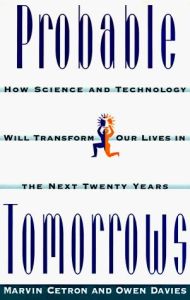Join getAbstract to access the summary!

Join getAbstract to access the summary!
Marvin Cetron and Owen Davies
Probable Tomorrows
How Science and Technology Will Transform Our Lives in the Next Twenty Years
St. Martin’s Press, 1997
What's inside?
The crystal ball focuses on technology and sees everything growing smaller and faster, except people — who will grow older, but healthier.
Recommendation
Authors Marvin Cetron and Owen Davies examine anticipated trends in technology over the next 15 to 20 years. They categorize their studies under digital systems, the Internet, high-tech materials, nanotechnology, transportation, space, energy, medicine and environmental remediation. They examine specific technological proposals and estimate their chances for success within the next two decades. An appendix lists specific predictions and the probability that each will come to pass. The book is necessarily superficial, since it covers such a broad range of topics. Unavoidably, some predictions are already somewhat dated, particularly those about industries that undergo constant, rapid change, such as medicine, computers and the Internet. However, the book provides a thorough survey of the range of technologies that are under study and development. This book is a rich source of ideas and makes interesting connections among disparate technologies. getAbstract recommends the book to all corporate planners, trend-researchers and long-term thinkers.
Summary
About the Authors
Marvin Cetron is founder and president of Forecasting International. A resident of Virginia, he has been a consultant for more than half of the Fortune 500 companies in the U.S. and for various government agencies internationally. New Hampshire resident Owen Davies is a former senior editor at Omni magazine and a freelance writer specializing in science, technology and the future. Together, they wrote Crystal Globe, Educational Renaissance and American Renaissance.

















Comment on this summary